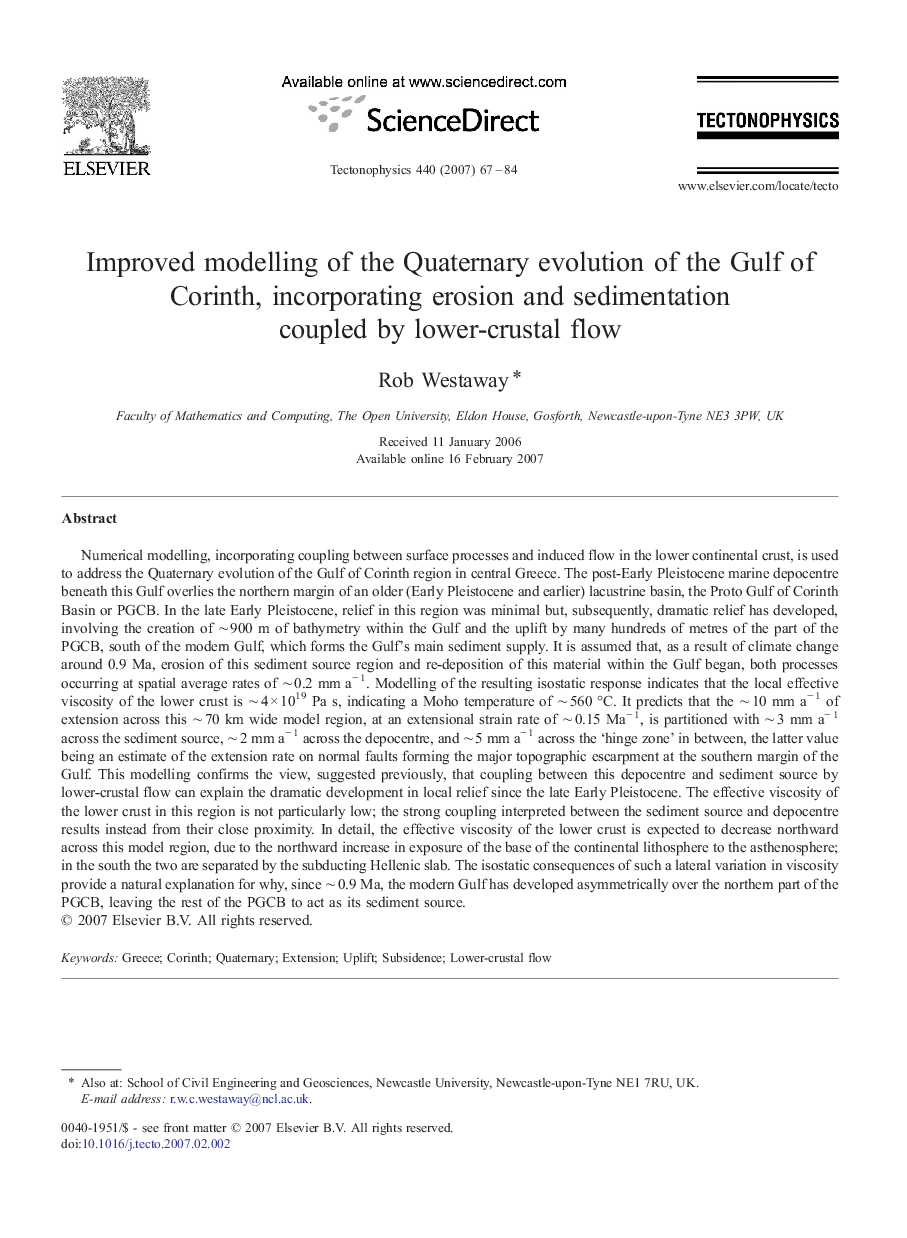| کد مقاله | کد نشریه | سال انتشار | مقاله انگلیسی | نسخه تمام متن |
|---|---|---|---|---|
| 4694634 | 1636929 | 2007 | 18 صفحه PDF | دانلود رایگان |
عنوان انگلیسی مقاله ISI
Improved modelling of the Quaternary evolution of the Gulf of Corinth, incorporating erosion and sedimentation coupled by lower-crustal flow
دانلود مقاله + سفارش ترجمه
دانلود مقاله ISI انگلیسی
رایگان برای ایرانیان
کلمات کلیدی
موضوعات مرتبط
مهندسی و علوم پایه
علوم زمین و سیارات
فرآیندهای سطح زمین
پیش نمایش صفحه اول مقاله

چکیده انگلیسی
Numerical modelling, incorporating coupling between surface processes and induced flow in the lower continental crust, is used to address the Quaternary evolution of the Gulf of Corinth region in central Greece. The post-Early Pleistocene marine depocentre beneath this Gulf overlies the northern margin of an older (Early Pleistocene and earlier) lacustrine basin, the Proto Gulf of Corinth Basin or PGCB. In the late Early Pleistocene, relief in this region was minimal but, subsequently, dramatic relief has developed, involving the creation of â¼Â 900 m of bathymetry within the Gulf and the uplift by many hundreds of metres of the part of the PGCB, south of the modern Gulf, which forms the Gulf's main sediment supply. It is assumed that, as a result of climate change around 0.9 Ma, erosion of this sediment source region and re-deposition of this material within the Gulf began, both processes occurring at spatial average rates of â¼Â 0.2 mm aâ 1. Modelling of the resulting isostatic response indicates that the local effective viscosity of the lower crust is â¼Â 4 Ã 1019 Pa s, indicating a Moho temperature of â¼Â 560 °C. It predicts that the â¼Â 10 mm aâ 1 of extension across this â¼Â 70 km wide model region, at an extensional strain rate of â¼Â 0.15 Maâ 1, is partitioned with â¼Â 3 mm aâ 1 across the sediment source, â¼Â 2 mm aâ 1 across the depocentre, and â¼Â 5 mm aâ 1 across the 'hinge zone' in between, the latter value being an estimate of the extension rate on normal faults forming the major topographic escarpment at the southern margin of the Gulf. This modelling confirms the view, suggested previously, that coupling between this depocentre and sediment source by lower-crustal flow can explain the dramatic development in local relief since the late Early Pleistocene. The effective viscosity of the lower crust in this region is not particularly low; the strong coupling interpreted between the sediment source and depocentre results instead from their close proximity. In detail, the effective viscosity of the lower crust is expected to decrease northward across this model region, due to the northward increase in exposure of the base of the continental lithosphere to the asthenosphere; in the south the two are separated by the subducting Hellenic slab. The isostatic consequences of such a lateral variation in viscosity provide a natural explanation for why, since â¼Â 0.9 Ma, the modern Gulf has developed asymmetrically over the northern part of the PGCB, leaving the rest of the PGCB to act as its sediment source.
ناشر
Database: Elsevier - ScienceDirect (ساینس دایرکت)
Journal: Tectonophysics - Volume 440, Issues 1â4, 1 August 2007, Pages 67-84
Journal: Tectonophysics - Volume 440, Issues 1â4, 1 August 2007, Pages 67-84
نویسندگان
Rob Westaway,